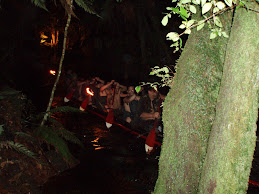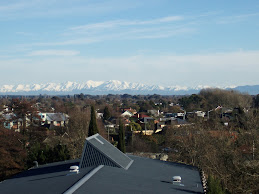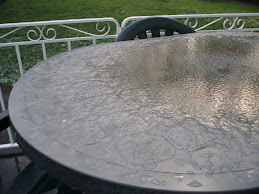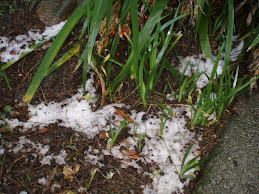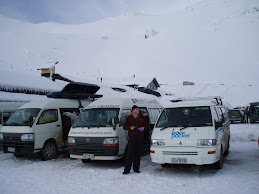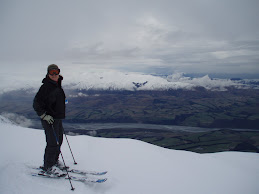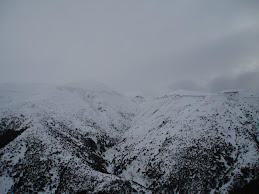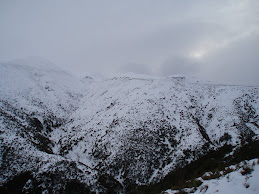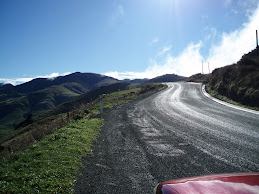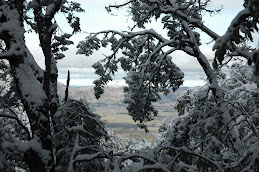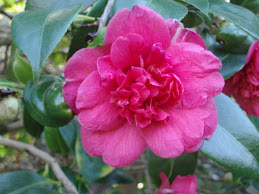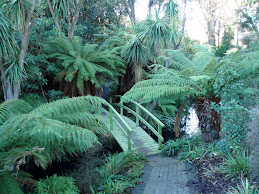and gale force winds. So much for the beautiful spring blossoms - most of the lovely cherry trees are now completely denuded.

This photo was taken last week on campus before the wind and rain.

Several huge tree branches came down along the path to campus. Walking home under the eucalyptus trees made you realize why one of their nicknames is widow maker. There were small branches blowing everywhere. This photo was taken on a nice day.
After such a day, Sunday was a complete 180° change. Despite the frosty start it was a picture postcard perfect day with nary a cloud in sight and pleasant spring temps. We opted for something close to home. We drove across ChCh to the coast and hiked the raw and dramatic cliff edge walk from the suburb of Scarborough along Scarborough Head to the beach at Taylor’s Mistake (the name is said to have been given when Captain Taylor of the US ship Vulga mistook the bay for the entrance to Lyttelton Harbour) in Hobson Bay and then to the gun battery emplacements (NZ was worried about Japanese invasion during WWII) on Godley Head. It is hard to believe that this area is within the ChCh city limits.
 This is the view across Sumner beach to ChCh proper with the Canterbury Plain and the snow-capped Alps in the distance.
This is the view across Sumner beach to ChCh proper with the Canterbury Plain and the snow-capped Alps in the distance.
This view is on the Pacific Coast side of Scarborough Head.
Sumner and Scarborough are some of the toniest of ChCh suburbs. There were some amazingly beautiful homes along the cliffs. One even had a bridge walkway from the third floor bedroom over to the hot tub gazebo. But I wouldn’t want people walking by my hot tub. Baches hang improbably off the cliffside at several of the beaches. The word “bach” is a contraction of “bachelor”; the word refers to the home built huts that provide a refuge from the busy world. Some of the baches are built on public land and there has been a long standing dispute as to their fate, but they add a lot of character to the beaches.
 Doug as usual spotted a penguin in the bay. Even though we watched it for quite a while, it was too far away to positively identify the exact species. The walking track went across many sheep paddocks and a donkey pasture with Taylor’s Mistake beach in the background.
Doug as usual spotted a penguin in the bay. Even though we watched it for quite a while, it was too far away to positively identify the exact species. The walking track went across many sheep paddocks and a donkey pasture with Taylor’s Mistake beach in the background.


We drove around to the top of Godley Head after our hike to watch the paragliders. There were also model gliders taking advantage of the prefect conditions.
 We ended the day trying to find Matson’s Beer. The White House by the Bridge was closed. So no luck this time. I then found with a little internet research that the brewery in here in ChCh. Doug will get his surprise soon.
We ended the day trying to find Matson’s Beer. The White House by the Bridge was closed. So no luck this time. I then found with a little internet research that the brewery in here in ChCh. Doug will get his surprise soon.In our search we did find whitebait in a fish store and decided to try it. It is quite a local delicacy at NZ$80 per kg. We knew we had to try it after seeing them being netted on the west coast. New Zealand whitebait are the juvenile of certain glaxiids which mature and live as adults in rivers with native forest surrounds. The larvae of these galaxiids are swept down to the ocean where they hatch and the sprats then move back up their home rivers as whitebait. They are best in an egg white omelette that does not mask the delicate flavour of the fish. We sautéed 125 g of fish with 4 egg whites. A lot of people are put off by the slimy little worm-looking things but it was delicious – a bit salty and slightly crunchy. It is even heart healthy for Doug with just egg whites.











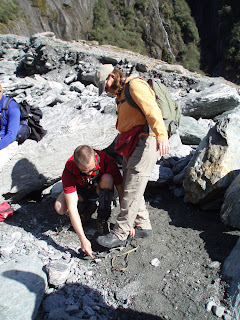


















 Okarito KiwiTours claims to have an 85% success rate at viewing the birds. We arrived in the small village with plenty of time to set up camp and eat our sandwiches before meeting up with Ian, our Okarito KiwiTour Guide. At the office (his garage) we also met Paul, a guide in training, and three young people making a video about eco-tourism. We were each outfitted with a walkie-talkie radio, safety vest, and torch (flashlight).
Okarito KiwiTours claims to have an 85% success rate at viewing the birds. We arrived in the small village with plenty of time to set up camp and eat our sandwiches before meeting up with Ian, our Okarito KiwiTour Guide. At the office (his garage) we also met Paul, a guide in training, and three young people making a video about eco-tourism. We were each outfitted with a walkie-talkie radio, safety vest, and torch (flashlight).















 We visited the house site to see the progress of the building. The architecture of the home is based on the traditional Maori marae. Doug was disappointed that they have not yet started making the clay/pumice walls.
We visited the house site to see the progress of the building. The architecture of the home is based on the traditional Maori marae. Doug was disappointed that they have not yet started making the clay/pumice walls.










